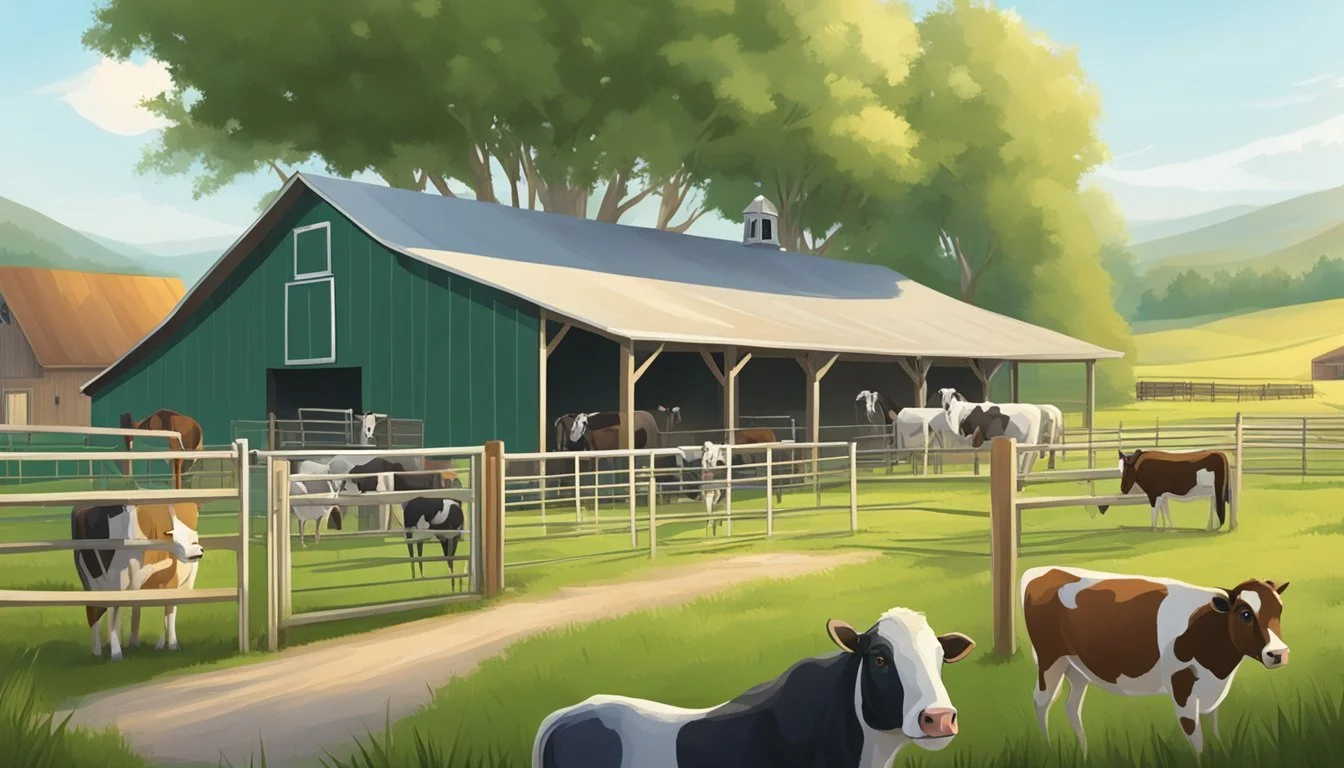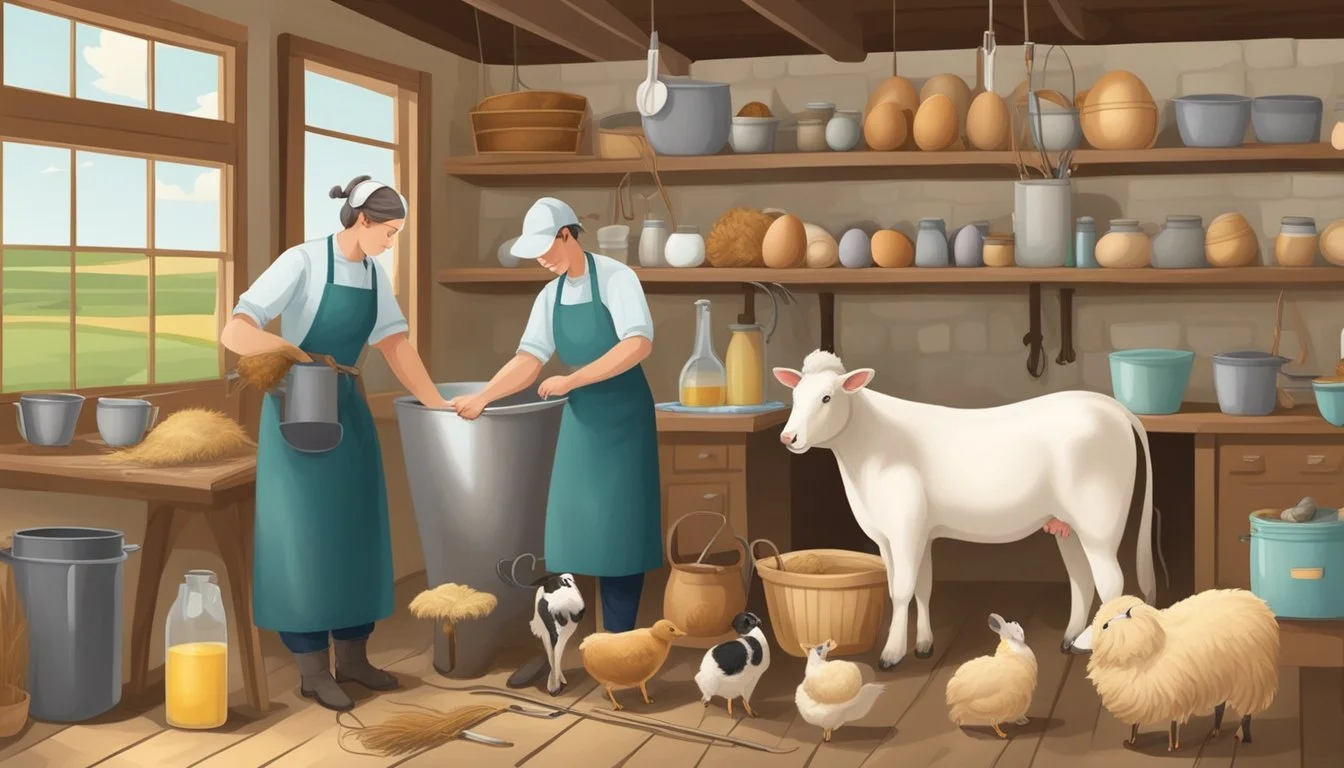Essential Veterinary Supplies for Optimal Animal Health Care on Your Homestead
A Comprehensive Guide
Optimal animal health care is a cornerstone of successful homesteading. With the right veterinary supplies on hand, homesteaders can prevent common health issues, swiftly address injuries and illnesses, and maintain their animals' overall well-being. The health of livestock and pets directly impacts the productivity and sustainability of a homestead, making it vital for owners to invest in quality veterinary supplies.
A comprehensive approach to animal care on a homestead includes regular check-ups with a trusted veterinarian, a well-stocked medicine cabinet, and equipment for routine diagnostics. From supplying the correct nutrition and ensuring adequate exercise to recognizing and managing behavioral issues, each aspect of animal care requires specific tools and knowledge. Additionally, emergency repair supplies are indispensable, as they allow for quick response to unforeseen situations involving animal housing and safety.
By maintaining a selection of essential veterinary supplies, homesteaders are equipped to create a safe and healthy environment for their animals. This not only benefits the farm animals and pets but also supports the homesteader's lifestyle of self-reliance. Preparedness in animal health care is a proactive measure that safeguards the homestead's vibrant future.
Understanding the Homestead Environment
To manage a homestead effectively, one needs to be keenly aware of the roles animals play, their specific care requirements, and the challenges posed by predators and pests.
Role of Livestock on Your Homestead
Livestock are integral to the homestead ecosystem. They provide essential resources such as meat, milk, eggs, and labor for various tasks. Understanding each animal's role ensures they contribute positively to the homestead's sustainability and productivity.
Common Homestead Animals and Their Needs
Homesteads commonly raise a variety of animals, each with unique needs:
Chickens: Require coops, space for foraging, and protection from elements and predators.
Goats: Need secure fencing, climbing spaces, and appropriate shelter.
Horses: Require large grazing areas, stables, and regular exercise.
Cattle: Need vast pastures, water access, and winter feed provisioning.
Proper nutrition, housing, and routine health checks are crucial for their well-being.
Addressing the Challenges of Predators and Pests
Homesteads must be vigilant against predators and pests:
Predators: Wolves, foxes, and birds of prey threaten smaller livestock. Robust fencing, secure housing, and guardian animals mitigate these risks.
Pests: Flies, ticks, and rodents can spread disease and stress animals. Regular hygiene practices, rodent control, and parasite prevention strategies are key to managing these threats.
Optimizing Nutrition and Feed Management
Proper nutrition is vital for maintaining animal health on a homestead. This optimization includes understanding animals' specific dietary needs, safely storing feeds to preserve their nutritional value, and selecting appropriate feed types tailored to different animals.
Essential Feed and Nutritional Requirements
Animals require a balance of proteins, carbohydrates, fats, vitamins, and minerals for optimal health. Feed types such as hay and grain are staples for many herbivores, providing essential nutrients and fiber. It's crucial to ensure protein requirements are met, particularly for growing, pregnant, or lactating animals, which may need higher levels. Treats should be given sparingly, complementing a diet rather than replacing essential feed.
Animal Type: Ruminants, Protein Needs: High, Main Feed Type: Quality hay, Supplements Needed: Mineral and salt licks
Animal Type: Poultry, Protein Needs: Moderate-High, Main Feed Type: Grain blends, Supplements Needed: Grit for digestion
Animal Type: Swine, Protein Needs: High, Main Feed Type: Commercial rations, Supplements Needed: Additional vitamins
Animal Type: Equine, Protein Needs: Moderate, Main Feed Type: Hay & specialty grain, Supplements Needed: Balanced vitamin mix
Safe Food Storage and Preservation
Storage of feed and hay is essential in preventing spoilage and nutrient loss. Keep all feeds in cool, dry conditions, away from direct sunlight and moisture to prevent the growth of mold. Secure storage bins should be used to protect feed from pests and vermin. Careful preservation ensures that the nutritional value of feed is maintained over time, and risks of contamination and illness are minimized.
Choosing the Right Feed Types for Different Animals
Selecting the correct type of feed for each species is mandatory. Herbivores, such as cattle and horses, primarily consume hay, while omnivores such as pigs will require a variety of grains with suitable protein content. Knowing the nutritional needs of each animal aids in choosing feeds that promote health and productivity.
Ruminants: High-fiber feed like hay is essential for a healthy digestive system.
Poultry: Requires grain-based feeds high in protein, complemented by feed formulated for egg-layers or broilers.
Swine: They need diverse diets, with commercial feeds designed for pigs often being the optimum choice for balanced nutrition.
Maintaining Adequate Shelter and Housing
Creating a safe and healthy environment for animals on your homestead is vital. Shelter and housing are critical to protect animals from extreme weather, predators, and to ensure their general well-being.
Critical Elements of Animal Shelter
An animal's shelter should be sturdy, well-ventilated, and insulated. Key components of proper shelter include:
Durability: Materials should withstand the animals' behavior and environmental stress.
Space: Adequate space for rest, movement, and isolation in case of illness.
Cleanliness: Easy-to-clean surfaces to maintain sanitation.
Comfort: Bedding that keeps animals dry and comfortable.
Effective Fencing and Security Measures
Proper fencing is essential for the safety and containment of animals. Key considerations:
Height and Material: Fencing should be tall enough to prevent escapes and made from materials that can resist chewing or digging.
Gates: Secure gates with locks to prevent unauthorized access.
Regular Inspection: Check for damage or wear to repair promptly.
Housing Adaptations for Different Weather Events
Shelters must withstand various weather conditions to keep animals safe. Some adaptations include:
Insulation: Proper insulation for temperature regulation during extreme cold or heat.
Waterproofing: Roofs and walls should be waterproof to keep animals dry during rain.
Ventilation: Sufficient airflow to reduce humidity and provide fresh air.
By following these guidelines, homesteaders can ensure that their animals have the protection and comfort they need to thrive.
Ensuring a Reliable Water Supply
Providing animals with a clean and reliable water supply is critical for maintaining their health and productivity on your homestead. Safe water is necessary for both drinking and metabolic processes within the animal's body.
Water Sources and Quality for Animals
Natural Water Sources: When securing water for your homestead animals, consider the natural sources available, such as wells, springs, and rainwater collection. These sources can be cost-effective but must be routinely tested to ensure they are free of contaminants that can harm animal health.
Testing Parameters: Test for pH, microbial contamination, and chemical pollutants.
Frequency: Conduct quality tests at least bi-annually or as recommended by local agricultural extensions.
Provided Water Sources: Municipal or rural water systems provide another option. They are typically consistent in quality due to regulatory standards, but disruptions can occur. Always have a backup supply in case of emergencies.
Factors Affecting Quality:
Dietary Content: Certain feeds can affect the water intake and hydration status of animals.
Environmental Stress: Temperature and humidity can impact an animal's water requirements.
Methods for Water Purification and Storage
Purification Techniques: Purification methods are crucial in ensuring that water remains free from harmful organisms and chemicals that could impact animal health.
Boiling: The simplest method, killing most pathogens.
Chemical Treatment: Using substances like sodium hypochlorite for disinfection.
Filtration: Removing particulates and some pathogens.
It's imperative to follow the correct dosages and procedures for each method to ensure effectiveness and safety.
Storage Solutions:
Clean Containers: Store water in clean, non-toxic containers to prevent contamination.
Regular Cleaning: Establish a routine for cleaning storage tanks to prevent biofilm buildup.
Protection: Shield water supplies from direct sunlight and freezing temperatures.
Health Care and Disease Prevention
Providing optimal health care and preventing disease is crucial for maintaining the welfare of animals on a homestead. A comprehensive approach to veterinary care ensures that animals receive appropriate vaccinations, emergency treatment is available when needed, and medications are administered correctly.
Vaccinations and Routine Medical Care
Regular vaccinations and medical check-ups are the cornerstones of preventive health care. They protect against a variety of diseases, some of which can be fatal. A veterinarian should establish a vaccination schedule tailored to the specific risks in the area and the individual animal's needs.
Core vaccines are essential for all animals and protect against widespread and severe diseases.
Non-core vaccines are administered based on the animal's lifestyle, environment, and geographic threats.
Routine care also involves regular screenings for parasites, and consistent monitoring for signs of illness.
First Aid Kits and Emergency Preparedness
Every homestead should have a well-stocked first aid kit for animals, prepared in consultation with a veterinarian. The kit should include:
Bandages and wound dressings
Antiseptics
A thermometer
Emergency medications such as epinephrine
Tools like tweezers and scissors
It's essential for caregivers to familiarize themselves with basic first aid procedures and create an emergency plan, which includes contact details for the nearest veterinary emergency clinic.
Handling and Administering Medications
Responsible medication management involves:
Storing medications properly to preserve their efficacy
Understanding the dosage and administration routes
Keeping accurate records of all treatments
For antibiotics and other critical medications, adherence to the prescribed treatment regimen is essential to prevent antibiotic resistance and ensure effective disease control. Caregivers should receive proper instruction on medication administration techniques and the importance of completing the full course of treatment, even if the animal appears to have recovered.
Comprehensive Breeding and Rearing Practices
In homesteading, the success of breeding and rearing practices hinges not only on selecting suitable breeds but also on the meticulous management of their growth stages. Each breed may require specific considerations based on their genetic traits, while the rearing process demands a strategic and methodical approach to ensure the animals reach their full potential.
Selecting and Managing Breeds for Homesteading
When selecting breeds for a homestead, it is crucial to consider the breeds' adaptability to the local environment, their intended purpose, and the homesteader’s level of experience. Hearty breeds with a proven track record of thriving in similar climatic conditions should top the list.
Dairy Cattle: For milk production, breeds like Holstein and Jersey are popular due to high yield and rich milk, respectively.
Beef Cattle: Angus and Hereford are preferred for their ease of management and marbling quality.
One's experience in animal husbandry can dictate the success with different breeds. Beginners might favor breeds known for their hardiness and low maintenance, whereas more experienced homesteaders could manage breeds that require intricate care.
Optimal Practices for Rearing Young Animals
The rearing of young animals is a critical phase in homesteading that shapes their health, productivity, and longevity. Homesteaders should adopt a lifetime approach to nutritional management, starting from the early stages of an animal's life.
Nutrition for Growth: Appropriate feeding regimens tailored to the developmental stages foster optimal growth. This includes colostrum for newborns and age-appropriate feed as they grow.
Health Management: Regular veterinary checkups and vaccinations are essential to prevent diseases and address any health issues promptly.
The homesteader must also ensure young animals have enough space for growth and are kept in a stress-free environment to support healthy development. Good rearing practices from the onset position young livestock for a productive life on the homestead.
Sustainable Agriculture and Resource Management
Achieving optimal animal health care on a homestead necessitates a strategic approach to sustainable agriculture and resource management. Here, the focus is on integrating livestock with crop production and utilizing organic waste to enhance soil health, all within the framework of a sustainable homesteading lifestyle.
Incorporating Livestock into Crop Production
In homesteads, livestock are not just valuable for their products but also play a crucial role in crop production. By integrating animal herds with garden plots, farmers can ensure a cyclical nutrient flow. Animals graze on cover crops and crop residues, converting these into manure, which in turn replenishes soil fertility.
Benefits of Livestock Integration:
Natural Fertilizer: Livestock manure is rich in essential nutrients for plant growth.
Pest Control: Certain livestock can aid in controlling crop pests, reducing the need for chemical interventions.
Soil Aeration: The movement and grazing activity of animals contribute to soil aeration, beneficial for root development.
Utilizing Manure and Compost for Soil Health
A key component of the homesteading lifestyle is the creation and use of compost and manure to maintain soil health. Transforming livestock waste into compost is an environmentally friendly approach to waste management.
Composting Process:
Collection: Manure, along with other organic waste from the garden, is collected.
Decomposition: Over time, with proper aeration and moisture, the waste decomposes into rich compost.
Application: Finished compost is applied to garden beds, providing a slow-release, nutrient-rich amendment to the soil.
Through these practices, homesteaders can sustainably manage resources while ensuring the well-being of their animals and the health of their gardens.
Tools and Equipment Essentials
In providing comprehensive care for animals on a homestead, certain tools and equipment are indispensable. From diagnosis to treatment, the right supplies ensure efficient and effective management of animal health.
Critical Equipment for Everyday Tasks
Stethoscope: A cornerstone tool for veterinarians, the stethoscope is integral for assessing the health of animals, allowing vets to listen to heart and lung sounds in creatures of various sizes.
Scissors: They must have sharp, durable veterinary scissors for tasks ranging from cutting bandages to surgical preparation.
Exam Tables: To conduct thorough examinations, sturdy exam tables are necessary. They must be easily sanitized and able to support animals of different weights.
Cages: Proper housing like secure boarding cages is essential for containing animals during recovery or routine care.
Selecting Durable and Reliable Tools
When buying equipment for a homestead's veterinary care, durability and reliability must be top priorities.
Material Quality: Items like stainless steel scissors resist corrosion and are easier to sterilize, making them a wise long-term investment.
Brand Reputation: Purchasers should consider equipment from reputable manufacturers known for their commitment to veterinary care standards.
Ease of Use: Tools should be ergonomic, reducing fatigue for those performing repetitive tasks, such as dental care involving scalers and polishers.
For any veterinary practice, but especially those on a homestead, investing in the right equipment is not a mere expenditure but a vital contribution to the health and well-being of the animals.
Integrating Animals into the Homesteading Lifestyle
Incorporating animals into a homesteading lifestyle requires consideration for their physical needs and their role in the ecosystem of the homestead. They provide more than just resources; they also bring companionship and help establish a self-sustaining environment.
Benefits of Companionship and Livestock Integration
Companionship plays a significant role in a homestead setting. It benefits not only the homesteader but also the animals. Livestock such as cows, goats, and chickens enrich the homesteading experience by providing:
Economic advantages: Animals offer products like milk, eggs, and wool for personal use or for sale.
Self-sufficiency: They can contribute to crop pollination and natural soil fertilization through their waste.
Emotional support: The bond between humans and animals can enhance mental well-being.
Companionship with animals fosters a symbiotic relationship where both parties thrive. They become an integral part of a homesteader's daily routine and contribute to the homestead in numerous tangible and intangible ways.
Social Structures and Exercise for Homestead Animals
Understanding and facilitating proper social structures for animals is crucial. Many animals are social by nature and require interaction with their own kind, which:
Promotes natural behaviors essential for their well-being
Decreases stress through mutual grooming or play
Providing daily exercise for homestead animals is equally important. It ensures:
Improved physical health through muscle development and cardiovascular health
Behavioral enrichment that prevents destructive habits
Homesteaders must create an environment where livestock can freely roam or engage in activities that mimic their natural behaviors. This inclusion not only supports their health but also the health of the entire homestead ecosystem.
Effective Record Keeping and Financial Planning
Effective record keeping is a cornerstone of any successful homestead that includes animal health care services. Veterinarians and animal caretakers must maintain clear and accurate detailed clinical and client records. These records are essential for comprehensive patient care and can be critical for resolving disputes. Prepared veterinarians are able to track the health history and treatment of each animal with precision.
Financial planning is equally crucial in a veterinary setting. It involves periodic monitoring of financial and operational reports. This consistent review assists in understanding a practice's financial health and ensures profitability. Homestead owners need to prepare and adhere to a budget to achieve their animal health care goals.
Key Components for Record Keeping:
Patient Information: Tracking of each animal's medical history, including treatments and outcomes.
Client Details: Recording owner information and their interactions with the practice.
Essential Financial Planning Tools:
Budgets: Establishing financial benchmarks for the practice.
Operational Reports: Frequently assessing practice performance versus set goals.
By focusing on these aspects, veterinarians and homestead managers can ensure a well-organized practice where both animal welfare and financial health are prioritized. Experience shows that meticulous attention to record keeping and financial planning paves the way to a thriving, sustainable practice.
Harvesting and Utilizing Animal Products
Productive livestock management directly impacts the quality and quantity of meat, milk, and eggs. It's crucial for homesteaders to understand efficient methods for harvesting and processing these resources.
Maximizing Meat, Milk, and Egg Production
Meat: To maximize meat production, one should focus on breeds known for their high yield and feed efficiency. Ensuring proper veterinary care and nutrition can lead to enhanced growth rates and meat quality. A rigid schedule for deworming and vaccinations will keep the animals healthy and productive.
Milk: Milk production thrives on consistency in feeding, milking routines, and optimal herd health management. Dairy animals require a balanced diet rich in energy, protein, and minerals. Regularly monitoring milk yield and quality can help detect health issues early.
Egg: Selection of prolific laying breeds and provision of a nutritious diet, geared towards layers, enhances egg production. Maintaining clean and comfortable nesting areas encourages laying and ensures the production of clean eggs.
Processing and Selling Homestead-Produced Goods
Meat: Processing meat on the homestead necessitates a clean and sanitized environment. One must be knowledgeable about humane slaughtering techniques, proper butchering methods, and storage requirements to ensure safety and quality.
Milk: Safe handling of milk involves rapid cooling to reduce bacterial growth and maintaining a clean milking apparatus. Homesteaders may consider pasteurization to extend shelf life and meet regulatory standards for selling dairy products.
For sale:
Meat must comply with local regulations regarding slaughter and sales. It's essential to label products accurately, highlighting cuts and any value-added processing.
Milk sales require adherence to food safety laws. Freshness, fat content, and whether the milk is raw or pasteurized should be clearly stated.
Conclusion
In managing a homestead, one's approach to animal health care is paramount. Veterinary supplies are a critical component in maintaining a healthy animal population. Homesteaders should ensure a regularly replenished inventory that includes:
Basic first aid items
Vaccines and dewormers
Nutritional supplements
Antibiotics, as prescribed
Investing in these supplies represents a commitment to preventative care, which can reduce the likelihood of more serious health issues. Staying vigilant about animal behavior and potential symptoms allows for prompt intervention, mitigating the spread of disease and discomfort among livestock.
It is worth noting that the relationship with a trusted veterinarian cannot be understated. Professionals can offer guidance tailored to the specific needs of the homestead, ensuring that each animal receives optimal care.
Finally, utilization of veterinary supplies should be coupled with good practices in nutrition, exercise, and shelter. This holistic approach is what ultimately creates a sustainable and resilient homestead. They are encouraged to seek continuous education on animal health to adapt and respond to the dynamic needs of homestead animal care.












